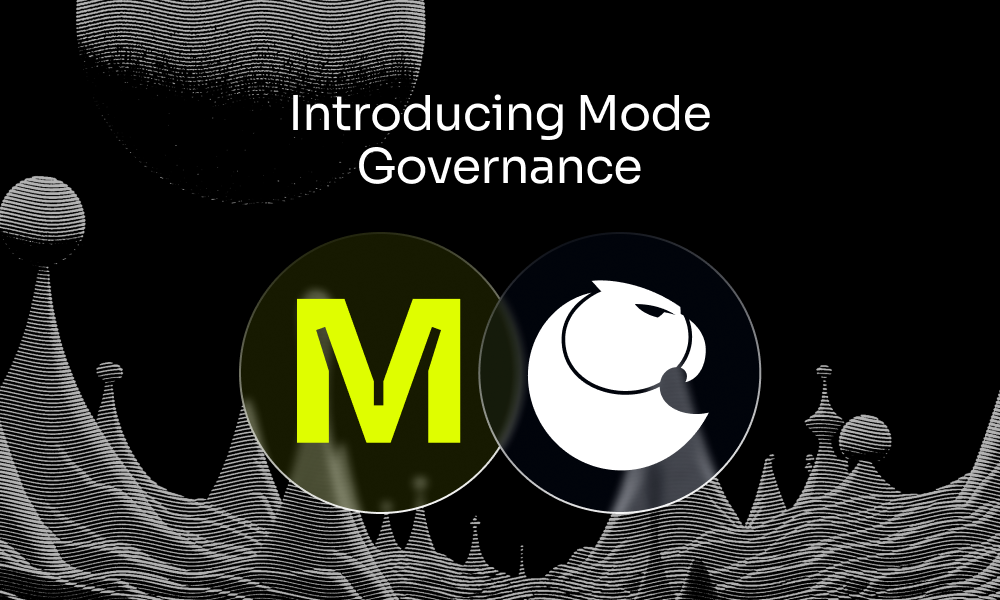Introducing Mode Governance
We’re excited to work with Mode, the first L2 to implement a modernized vote escrow (ve) and gauge-based governance model.
Aragon

We’re excited to work with Mode, the first L2 to implement a modernized vote escrow (ve) and gauge-based governance model. This breakthrough in applying ve and gauges to a rollup ecosystem introduces a dynamic governance model that fosters incentive alignment, reduces coordination overhead, and drives network growth.
TLDR:
- There is no long-term locking requirement, token holders can stake or unstake at any time with warm-up and cool-down periods;
- veStaker supports multiple tokens: MODE and BPT (80/20 MODE/WETH);
- Staking tokens exponentially increases voting power with each epoch;
- Stakers allocate a percentage of their voting power to gauges to direct rewards;
- Rewards go to protocols in the network, rather than liquidity pools;
- Stakers receive $OP rewards for participating in governance;
- Incentives change with each season;
- Community members stake, vote, and claim rewards directly in the Mode Governance Hub.
As an AIFi-focused L2, Mode builds infrastructure, assets, and applications to scale decentralized finance (DeFi) to billions of users globally. Mode is powered by Optimism’s OP stack and is working alongside Optimism to build the Superchain. By drawing on the successes and lessons learned throughout the history of DeFi governance, Mode is paving the way for a new chapter in ve governance.

What Makes Mode's Governance Unique
Mode brought together a group of industry leaders to modernize ve and gauge-based governance to this new use case, including experts from Balancer, Aura, Aragon, and others. This collaboration led to breakthroughs that push governance towards deeper incentive alignment, less coordination overhead, and ecosystem growth.
The solution encourages governance participation by incentivizing voters with exponential voting power and rewards, without enforcing long-term lockups. veMODE and veBPT holders can then allocate their voting power to gauges directing the distribution of rewards amongst protocols on the network. The incentives for both veMODE and protocols adapt from season to season, keeping governance responsive and adaptable to ecosystem and market dynamics.
With their novel approach requiring custom governance contracts and the need to continuously adapt in the future, Mode chose to build on Aragon OSx. Aragon OSx is a next-generation modular DAO framework that’s built on a battle-tested foundation and optimized for adaptability.
Here is a breakdown of Mode’s full-stack novel governance solution, from the contracts to the UI:

veStaker
We worked alongside Mode to build a custom veStaker with novel features:
- Users can stake two different token types in a single position:
- veMODE, acquired by staking MODE tokens;
- veBPT, acquired by staking MODE/ETH Balancer liquidity tokens.
This novel feature unlocks the potential to allocate dynamic voting power across different groups of stakeholders, introducing dual governance incentives and capabilities. It also creates a more inclusive stakeholder base for governance participation. Tokenholders providing liquidity to the MODE/ETH pool earn fee revenue from trading activity, while contributing to supporting healthy onchain liquidity for the MODE token. They serve an essential ecosystem function, and it was important to include them in the governance process.
- Voting power increases exponentially over time: Mode’s Season 3 is broken down into six epochs where voters can increase their voting power exponentially (up to 6x if they stake for all six epochs) by staking their ve tokens for longer.
- No long-term locking requirement: There are no long-term locking requirements— token holders can stake or unstake at any time. There is simply a short warm-up period before veTokens can participate in governance and a short cool-down period before unstaking tokens, to ensure predictability and security in voting.
Customisation of ve contracts is a complex endeavor. Building on learnings from existing ve models, we constructed a modularized ve contract library which allows projects to safely and easily customize parameters with greater granularity. This enabled the Mode team to design a unique implementation of ve governance, without needing to draw on resources from their development team.

Gauge-Based Governance
Mode is implementing a gauge-based system for governance that empowers veMODE and veBPT holders to determine the distribution of rewards amongst protocols on the network. Protocols compete for a share in the incentive pool, which is allocated based on the percentage of votes earned. Allocating rewards across protocols is a novel approach that strategically uses incentives to foster network growth.
Gauge-based governance also reduces coordination overhead and voter fatigue, as token holders only need to allocate their voting power once, and can re-allocate each epoch. There is no need to continuously vote to direct incentives. In this system, token holders also no longer need to keep re-locking to the maximum duration in order to maximize their voting power and returns.
Together with Mode, we built a custom governance plugin that allows users who hold veTokens to allocate their voting power to a predetermined list of options. Voters can then set the percentage of voting power they wish to allocate to each option. Users who participate in gauge-based voting will receive $OP rewards. The rewards for both protocols and users will be distributed primarily via Merkl.
Aragon OSx allows for any governance logic to be programmed and implemented. New governance rules are isolated into plugins, making novel forms of governance safer and easier to develop. Once a plugin is published, any DAO can install it using the Aragon OSx plugin repository, fostering an interoperable governance ecosystem across the Ethereum community.

Seasonal Incentives & Adaptable Aragon OSx DAO
Mode’s governance system is deployed and governed by an Aragon OSx DAO, and can thus adapt as the community evolves its governance and incentive model. Mode plans to iterate and adjust the incentives for each individual season. This structured continuous improvement process allows Mode to easily apply learnings from previous seasons and remain adaptive to market dynamics. With a plugin architecture that allows DAOs to safely and easily change their governance logic, Aragon OSx ensures a predictable and secure upgrade path.

Mode Governance Hub
Finally, the Mode community has a dedicated place to participate in governance and guide the growth of the L2 ecosystem. Everything from staking to participating in gauges is in one consolidated UI. The Governance Hub has all of the features users need to participate in a familiar interface consistent with Mode’s branding, ensuring an intuitive and seamless experience for the community.
The Governance Hub was built with our Governance App Template. It allows projects to easily deploy a unique interface to interact with custom governance contracts, including the flows, features, and information needed to participate. Having a dedicated UI for governance prevents users from having to hop between governance platforms. This not only greatly improves the user experience, but ensures continuity between a project’s brand, products, and governance system.
Next Steps
This is only the beginning of Mode’s governance. The governance incentives will adapt season to season, and the learnings will be applied over time. The community will directly shape how Mode’s novel approach to governance evolves.
We’re modularizing ve contracts to make it easier for projects to adjust ve models to meet the needs of their ecosystems and communities. To learn more about implementing a custom ve model for your project, reach out here.
Subscribe to The Eagle for weekly news on the Aragon Network
